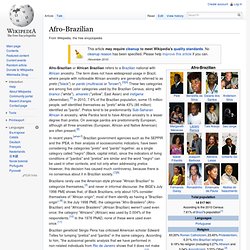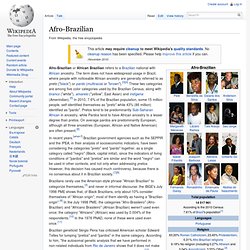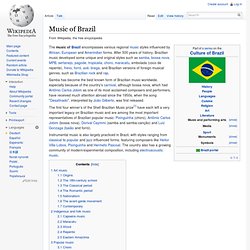

Orfeu Negro (1959. Afro Brazilian Dance. Afrobraziliandance.com. Food in Brazil Afro-Brazilian - Afro-Brazilian Food, Afro-Brazilian Cuisine - popular, dishes, history, meals, rice, people, favorite, make, customs, country, bread, bread, stew, different, cooking, meat, snack, dinner, sauce, culture. Recipes The majority of Afro-Brazilians live in the nine states of the country's northeastern section—home to nearly one-third of all Brazilians.

Most Afro-Brazilians live near the coastal regions where there is an abundance of rainfall. The northeast states have three distinct areas. The flat coastal strip, which literally meals "forest zone," has rich soil that is suitable for the cultivation of sugarcane plantations. Vast hills and mountain ranges begin just miles from the fertile coastline. The Portuguese claimed the rights to the territory that makes up modern-day Brazil in 1500, and in 1532, they began bringing African slaves to Brazil. Quiabo (Okra) Ingredients 2 cups water 1 pound small okra pods, topped and tailed ½ teaspoon butter Procedure Place the water in a large saucepan and bring to a boil over medium heat. Serves 4. Most of the descendents of the African slaves, who were brought to Brazil by the Portuguese in the 1500s, live in the state of Bahia.
EPD Photos Basic Rice. Food of Bahia, Brazil. By Ericivaldo Veiga, doctor of Social Sciences from the Catholic University of São Paulo.

This article was published originally by the Ministry of Foreigner Relations of Brazil. As such, the information is for public release, but many documents published by the Ministry don't reach the public. It is being published here as a means to spread information about Bahia and Brazil. Read also:Bahia travel informationBrazilian Cuisine Bahia cooking In this article, whose title is so rich in cooking metaphors such as flavor, essence and secret, I intend to provide a socio-anthropological account of the cuisine of Bahia including, as well, conditioning aspects such as tourism, which have led to what we dare calling the new cuisine of Bahia. Guided by the different forms of essence and secret, we will unveil some aspects of the cuisine of Bahia. Vatapá Acarajé With a heterogeneous geographic and cultural development, the hinterland is less populated and still stigmatized by constant droughts.
Muqueca. Afro-Brazilian Wiki Page. Afro-Brazilian or African Brazilian refers to a Brazilian national with African ancestry.

The term does not have widespread usage in Brazil, where people with noticeable African ancestry are generally referred to as preto ("black") or pardo (multiracial or "brown").[3][4] These two categories are among five color categories used by the Brazilian Census, along with branco ("white"), amarelo ("yellow", East Asian) and indígena (Amerindian).[5] In 2010, 7.6% of the Brazilian population, some 15 million people, self-identified themselves as "preto" while 43% (86 million) identified as "pardo". Pretos tend to be predominantly Sub-Saharan African in ancestry, while Pardos tend to have African ancestry to a lesser degree than pretos.
On average pardos are predominantly European, although all three ancestries (European, African and Native American) are often present.[6] In recent years,[when?] Afro-Brazilian Sports. Afro-Brazilian or African Brazilian refers to a Brazilian national with African ancestry.

The term does not have widespread usage in Brazil, where people with noticeable African ancestry are generally referred to as preto ("black") or pardo (multiracial or "brown").[3][4] These two categories are among five color categories used by the Brazilian Census, along with branco ("white"), amarelo ("yellow", East Asian) and indígena (Amerindian).[5] In 2010, 7.6% of the Brazilian population, some 15 million people, self-identified themselves as "preto" while 43% (86 million) identified as "pardo". Pretos tend to be predominantly Sub-Saharan African in ancestry, while Pardos tend to have African ancestry to a lesser degree than pretos.
On average pardos are predominantly European, although all three ancestries (European, African and Native American) are often present.[6] In recent years,[when?] Brazilian race/colour categories[edit] The first system referred by Telles is that of the IBGE. Afro-Brazilian Religion. Afro-Brazilian or African Brazilian refers to a Brazilian national with African ancestry.

The term does not have widespread usage in Brazil, where people with noticeable African ancestry are generally referred to as preto ("black") or pardo (multiracial or "brown").[3][4] These two categories are among five color categories used by the Brazilian Census, along with branco ("white"), amarelo ("yellow", East Asian) and indígena (Amerindian).[5] In 2010, 7.6% of the Brazilian population, some 15 million people, self-identified themselves as "preto" while 43% (86 million) identified as "pardo". Pretos tend to be predominantly Sub-Saharan African in ancestry, while Pardos tend to have African ancestry to a lesser degree than pretos.
Candomblé. Ilê Axé Iya Nassô Oká – Terreiro da Casa Branca Candomblé (Portuguese pronunciation: [kɐ̃dõˈblɛ], dance in honour of the gods) an African-originated or Afro-Brazilian religion, practiced mainly in Brazil[1] by the "povo de santo" (people of the saint).

It is a mixture of traditional Yoruba, Fon, Ewe and Bantu beliefs which originated from different regions in Africa.[1] It has also incorporated some aspects of the Catholicism over time.[1] It officially originated in Salvador, Bahia at the beginning of the 19th century when the first Candomblé temple was founded, but it traces back to the earliest days of the slave trade, when enslaved Africans brought their beliefs with them when they were shipped to Brazil.[1] Although Candomblé is practiced primarily in Brazil, it is also practiced in other countries, including Uruguay, Argentina, Venezuela, Colombia, Germany, Italy, Portugal and Spain, having as many as two million followers.[1][2] Overview[edit] History[edit]
AFRO-BRAZILIAN MUSIC by Mestre Gildo Valu. Music of Brazil. Samba has become the best known form of Brazilian music worldwide, especially because of the country's carnival, although bossa nova, which had Antônio Carlos Jobim as one of its most acclaimed composers and performers, have received much attention abroad since the 1950s, when the song "Desafinado", interpreted by João Gilberto, was first released.

Instrumental music is also largely practiced in Brazil, with styles ranging from classical to popular and jazz influenced forms, featuring composers like Heitor Villa-Lobos, Pixinguinha and Hermeto Pascoal. The country also has a growing community of modern/experimental composition, including electroacoustic music. Art music[edit] Origins[edit] Jongo, a dance and musical genre of African origin, c. 1822 The first registration of musical activity in Brazil comes from the activities of two Jesuit priests in 1549.
The 18th-century school[edit] The Classical period[edit]